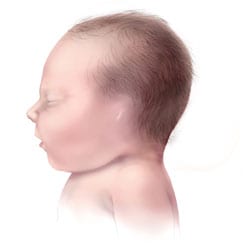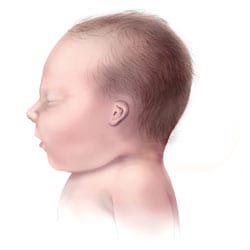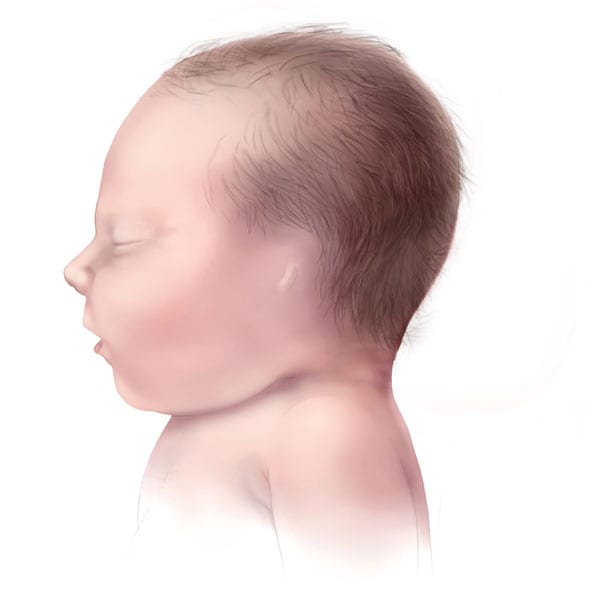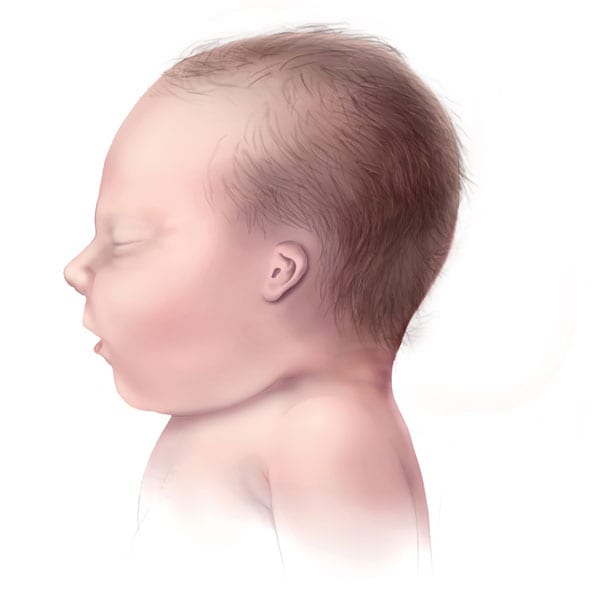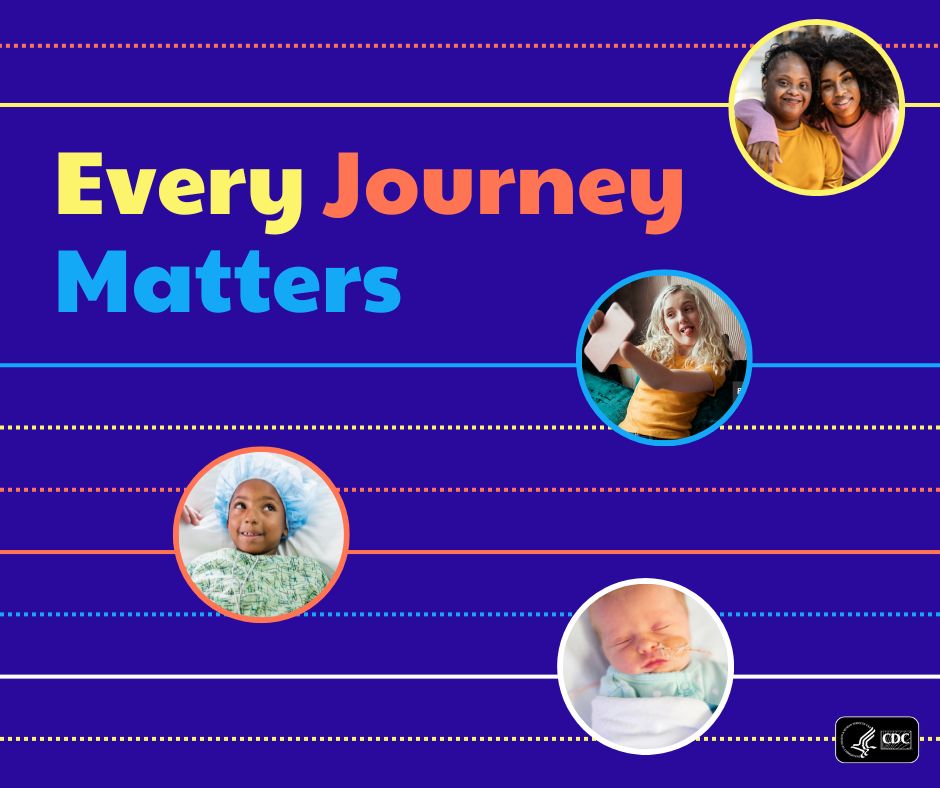Facts about Anotia/Microtia
Anotia and microtia are birth defects of a baby’s ear.
What are anotia and microtia?
Anotia and microtia are birth defects of a baby’s ear. Anotia happens when the external ear (the part of the ear that can be seen) is missing completely. Microtia happens when the external ear is small and not formed properly.
Anotia/microtia usually happens during the first few weeks of pregnancy. These defects can vary from being barely noticeable to being a major problem with how the ear formed. Most of the time, anotia/microtia affects how the baby’s ear looks, but usually the parts of the ear inside the head (the inner ear) are not affected. However, some babies with this defect also will have a narrow or missing ear canal.
Types of Microtia
There are four types of microtia, ranging from Type 1 to Type 4. Type 1 is the mildest form, where the ear retains its normal shape, but is smaller than usual. Type 4 is the most severe type where all external ear structures are missing —anotia. This condition can affect one or both ears. However, it is more common for babies to have only one affected ear.1-2
How Many Babies are Born with Anotia/Microtia?
Researchers estimate that about 1 in every 3,800 babies is born with anotia/microtia in the United States.3
Causes and Risk Factors
The causes of anotia/microtia among most infants are unknown. Some babies have anotia/microtia because of a change in their genes. In some cases, anotia/microtia occurs because of an abnormality in a single gene, which can cause a genetic syndrome. Another known cause for anotia/microtia is taking a medicine called isotretinoin (Accutane®) during pregnancy. This medicine can lead to a pattern of birth defects, which often includes anotia/microtia. These defects also are thought to be caused by a combination of genes and other factors, such as the things the mother comes in contact with in the environment or what the mother eats or drinks or certain medicines she uses during pregnancy.
Like many families of children with a birth defect, CDC wants to find out what causes them. Understanding the factors that are more common among babies with a birth defect will help us learn more about the causes. CDC funds the Centers for Birth Defects Research and Prevention, which collaborate on large studies such as the National Birth Defects Prevention Study (NBDPS; births 1997-2011) and the Birth Defects Study To Evaluate Pregnancy exposureS (BD-STEPS; began with births in 2014), to understand the causes of and risks for birth defects, including anotia/microtia.
Recently, CDC reported on important findings about some factors that increase the risk of having a baby with anotia or microtia:
- Diabetes ― Women who have diabetes before they get pregnant have been shown to be more at risk for having a baby with anotia/microtia, compared to women who did not have diabetes.4
- Maternal diet—Pregnant women who eat a diet lower in carbohydrates and folic acid might have an increased risk for having a baby with microtia, compared to all other pregnant women.5
CDC continues to study birth defects, such as anotia/microtia, and how to prevent them. If you are pregnant or thinking about becoming pregnant, talk with your doctor about ways to increase your chances of having a healthy baby.
Diagnosis
Anotia/microtia are visible at birth. A doctor will notice the problem by just examining the baby. A CT or CAT scan (special x-ray test) of the baby’s ear can provide a detailed picture of the ear. This will help the doctor see if the bones or other structures in the ear are affected. A doctor will also perform a thorough physical exam to look for any other birth defects that may be present.
Treatment
Treatment for babies with anotia/microtia depends on the type or severity of the condition. A healthcare provider or hearing specialist called an audiologist will test the baby’s hearing to determine any hearing loss in the ear(s) with the defect. Even a hearing loss in one ear can hurt school performance.6 All treatment options should be discussed and early action may provide better results. Hearing aids may be used to improve a child’s hearing ability and to help with speech development.
Surgery is used to reconstruct the external ear. The timing of surgery depends on the severity of the defect and the child’s age. Surgery is usually performed between 4 and 10 years of age. Further treatment may be necessary if the child has other birth defects present.
In the absence of other conditions, children with anotia/microtia can develop normally and lead healthy lives. Some children with anotia/microtia may have issues with self-esteem if they are concerned with visible differences between themselves and other children. Parent-to-parent support groups can prove to be useful for new families of babies with birth defects of the head and face, including anotia/microtia.
Other Resources
The views of these organizations are their own and do not reflect the official position of CDC.
- Children’s Craniofacial Association (CCA)
CCA addresses the medical, financial, psychosocial, emotional, and educational concerns relating to craniofacial conditions. - The National Craniofacial Association (FACES)
FACES is dedicated to assisting children and adults who have craniofacial disorders resulting from disease, accident, or birth.
References
- Canfield MA, Langlois PH, Nguyen LM, Scheuerle AE. Epidemiologic features and clinical subgroups of anotia/microtia in Texas. Birth Defects Research (Part A): Clinical and Molecular Teratology. 2009;85:905-913.
- Shaw GM, Carmichael SL, Kaidarova Z, Harris JA. Epidemiologic characteristics of anotia and microtia in California, 1989-1997. Birth Defects Research (Part A): Clinical and Molecular Teratology. 2004;70:472-475.
- Stallings EB, Isenburg JL, Mai CT, Liberman RF, Moore CA, Canfield MA, Salemi JL, Kirby RS, Short TD, Nembhard WN, Forestieri NE, Heinke D, Alverson CJ, Romitti PA, Huynh MP, Denson LE, Judson EM, Lupo PJ; National Birth Defects Prevention Network. Population-based birth defects data in the United States, 2011-2015: A focus on eye and ear defects. Birth Defects Res. 2018 Nov 15;110(19):1478-1486. doi: 10.1002/bdr2.1413. Epub 2018 Nov 16. PMID: 30444307; PMCID: PMC6705119.
- Correa A, Gilboa SM, Besser LM, Botto LD, Moore CA, Hobbs CA. Diabetes mellitus and birth defects. American Journal of Obstetrics and Gynecology. 2008;199:237.e1–9.
- Ma C, Shaw GM, Scheuerle AE, Canfield MA, Carmichael SL, and National Birth Defects Prevention Study. Association of microtia with maternal nutrition. Birth Defects Research (Part A): Clinical and Molecular Teratology. 2012;(94):1026-1032.
- Kuppler K, Lewis M, Evans AK. A review of unilateral hearing loss and academic performance: Is it time to reassess traditional dogmata? International Journal of Pediatrics and Otorhinolaryngology. 2013;77: 617-622.
